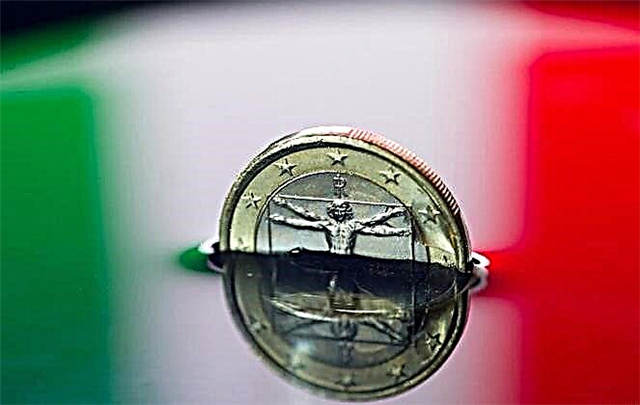Taxes in Italy are characterized by relatively high rates in the European Union. Their structure, as well as the payment procedure, are quite traditional. At the same time, in the country's fiscal system, there has recently been a tendency to introduce benefits for certain categories of payers and to reduce rates. In addition, certain types of tax payments are canceled. In Italy, there are taxes that can cause confusion among Russians. And the complexity of calculating tax payments determines the absence of a single codified document in the country.

Tax system of the Italian Republic
Italy has a very extensive taxation system. The legal framework contains over 350 legislative acts of a federal nature.
In general, the Italian tax system is built on the principles set out in the Constitution. The main emphasis in taxation is placed on direct taxes. They provide approximately 40% of the proceeds.
Indirect taxes provide up to 25% of all tax payments.
The taxation system is two-tier:
- national (state) taxes: income, income tax, VAT and others;
- local taxes.
The subjects of tax relations are legal entities and individuals with the status of both residents and non-residents of the country. The former pay taxes on all types of income (including foreign ones), and the latter only pay taxes on profits earned in Italy.
The main types of direct taxes
As in all other countries, direct taxes in Italy are levied on the payer's income and on the property belonging to him. Let's consider them in more detail.
Personal income tax
Taxes in Italy for individuals IRPEF (imposta sul reddito delle persone fisiche) are calculated on a progressive scale. The numbers are presented in the table:
| Income, EUR | Bid, % |
|---|---|
| 0-15 thousand | 23 |
| from 15 to 28 thousand | 27 |
| from 28 to 55 thousand | 38 |
| from 55 to 75 thousand | 41 |
| over 75 thousand | 43 |
Wages, bonuses and various compensations are subject to taxation. In addition, tax must be paid on income from:
- capital;
- individual labor activity;
- entrepreneurial activity.
The employer acts as a tax agent for citizens employed under an employment contract. It is he who calculates and deducts the due amount from the salary.
In Italy, there is an independent category of labor activity - casual work. The income tax to be paid by the performer who received the monetary remuneration, in this case, is 20%. Individuals who have not opened an individual enterprise and do not have a piva - VAT registration number work according to this scheme. The legislation stipulates that services that have brought in income no more than 5,000 euros per year are considered to be casual.
Income tax for organizations
Income tax IRES (imposta sul reddito delle società) is paid by legal entities of 3 categories:
- a foreign company, the majority of the board of directors of which is represented by residents of Italy;
- a non-resident who is an object of management of an Italian company and at the same time a holder of its shares;
- an institution whose actual governing body or legal address is located in Italy. Or a company doing business in the country for more than 183 days during the tax period.
Below are the main taxes in Italy for legal entities and their rates:
- Capital gains - 27.5%. A decrease in the rate to 5% is possible if the company conducts commercial activities and holds shares, accounted for as main financial assets, for at least 12 months.
- For the dividends transferred to a non-resident - 20%. A decrease in this indicator is also possible if the countries have concluded an agreement on the avoidance of double taxation. At the same rate, withholding tax is levied on dividends received from a non-resident company.
- Interest transferred to foreign companies is 20%. This rate is reduced to 12.5% if the source of interest is investment in government assets.
- For royalties paid to a non-resident - 22.5%.
Paid by IRES in two installments. By May 31, the company must transfer 40%, at the same time filing a declaration for the reporting year. The remaining 60% is paid until November 30 of the year that follows the reporting year.
Regional tax on the production activities of companies
 Tax payers IRAP (imposta regionale sulle attività produttive) are legal entities and individual entrepreneurs. Individuals can be exempted from this tax if they prove on a documentary basis that no production structure was formed to generate income (that is, employees were not hired).
Tax payers IRAP (imposta regionale sulle attività produttive) are legal entities and individual entrepreneurs. Individuals can be exempted from this tax if they prove on a documentary basis that no production structure was formed to generate income (that is, employees were not hired).
The IRAP rate is noticeably lower compared to the IRES. On average, in various regions, it is 4.25% of the profits of manufacturing enterprises and 8.5% of the income arising from the provision of services by the company for the transportation, sale and maintenance of products.
Payment terms: 40% is paid by June 30, the remaining 60% by November 30.
Single council tax
Taxation in Italy stipulates that owners of residential real estate, land plots / building areas, non-residential buildings and buildings must pay the IMU (imposta municipale unica) tax every year. However, the current law exempts owners of the Prima Casa - “first home” from paying this fee. It means a residential building that was registered in the register in the status of an immovable property, where the owner lives with his family.
And one more condition: the IMU tax is not paid if the house is not included in the category of luxury real estate.
Municipalities have the right to form a list of categories of citizens exempted from this tax. For example, the authorities of the communes can exempt disabled and elderly people from IMU payments.
There are two types of rates for calculating the council tax:
- Variable. It is applied in relation to objects from the category of secondary real estate and some other types of property. The base rate is 0.76%, but municipalities can change it.
- Regular. Valid when calculating IMU per luxury home. It is 0.4%.
The following rules apply to the due date: 50% of the due amount must be paid by June 16, and the balance must be paid by December 16.
The main types of indirect taxes
Indirect taxes are established on services and goods in the form of surcharges to the tariff or price. Paid upon receipt of services and upon purchase of commodity-material values of a consumer nature.
Value added tax
Of the indirect taxes, VAT in Italy (imposta sul valore aggiunto) is the main one. Since August 2021, its rate has increased and is now 22%. There is a list of goods for which VAT remained at 10%, but it is planned to raise it to 13%.
The country's updated parliament is discussing ways to prevent a further increase in IVA in 2021. As an alternative option, the possibility of introducing a single tax is being considered.
The government's previous plans included raising VAT (this is the common English abbreviation for VAT - Value Added Tax) to 24.5%, provided that the current economic situation persists.
Undoubtedly, such a significant tax increase will hit the business of small shops and small entrepreneurs, as well as negatively affect the lives of the poorest segments of the population of the Italian Republic.Creditors in the person of the European Commission insist on increasing the VAT, but Rome, with the growth of the economy, reserves the right not to comply with this requirement.
Tax on registration of legal acts
 The need to pay this tax arises when an act or a transaction being made requires state registration. By law, this procedure must be followed in the event of a transfer of ownership.
The need to pay this tax arises when an act or a transaction being made requires state registration. By law, this procedure must be followed in the event of a transfer of ownership.
It doesn’t come cheap. Here are just 2 examples:
- if real estate is purchased from a private person, the value of l'imposta di registro can be up to 2% of the cadastral value of the object. But not less than 1,000 euros.
- if an apartment is purchased from a developer and less than 5 years have passed since the completion of construction work, a fixed registration tax is paid - 200 euros.
It is important to know that the tax is paid to the notary after the registration of the deed of sale.
Tax levied on paperwork
Stamp duty - l'imposta di bollo - is levied through the sale by the state of revenue stamps or revenue paper required for the proper execution of a variety of commercial documents: written agreements and private contracts, invoices, checks, receipts, promissory notes.
The cost of letterhead ranges from € 0.21–0.77. With regard to the amount of tax, for example, on IOUs, about 0.01 euros is levied on each euro.
Gift tax
Any conscientious taxpayer is interested in the tax base applied to donated and inherited property - l'imposta di successione e donazione. Regardless of the status (resident or non-resident of Italy), the following rules apply:
- if the gifted person or heir is a child or the spouse of the donor, or the person who introduced it to the will, he will pay 4%. In this case, 1 million euros is not taxed at all;
- in case of inheritance or donation between brothers and sisters, you will have to pay 6%. Here, 100 thousand euros are deducted from the tax base for each heir or gifted person;
- other relatives who have proven the fact of kinship will pay the same 6%;
- persons who have no family ties with the testator / donor will have to pay 8%.
In the last two cases, there is no reduction in the taxable base for inheritance or a gift.
Other types of taxes
Other taxes apply in the Italian Republic. Let's consider some of them in more detail.
Immovable property tax
Property tax in Italy falls under the local category. Its base is the amount of potential income from the property. This indicator is calculated based on the cadastral value using several coefficients depending on the class of the object.
The size of the property tax rate is 0.76%. However, this indicator may differ in different municipalities. But in any case, the limit values in relation to the original bet are limited to a coefficient of 0.3.
Residents of the country can buy land for the construction of a private house. In this case, they will have to pay tax in the amount of 8% of the value of the site. But the size of the tax on agricultural land is almost 2 times more - 15%
It is important to know that residents of the country need to pay tax on property outside Italy. Then the contractual or assessed value of the real estate acts as the tax base. And the rate remains the same - 0.76%.
For this case, the legislation on the exclusion of double taxation is relevant: that is, in Italy this tax is not levied if it is paid in the Russian Federation.
Tourist tax
 The tourist tax (often also called the “resort tax”) is levied on travelers who stay at the host tourist structures operating in a number of Italian cities. Usually this fact is not voiced by the staff: the tourist simply pays the required amount directly upon check-in to the hotel. The specific value of the resort tax is displayed in a separate column on the invoice.
The tourist tax (often also called the “resort tax”) is levied on travelers who stay at the host tourist structures operating in a number of Italian cities. Usually this fact is not voiced by the staff: the tourist simply pays the required amount directly upon check-in to the hotel. The specific value of the resort tax is displayed in a separate column on the invoice.
To have an idea of the order of the numbers that characterize the tax on residence in Italy (this is another name for the tourist tax), study the data from the table. Please note that in the regional municipalities of the country it cannot exceed 5 euros.
| Hotel category | Hotels in Milan, per person per night, € | Hotels in Sicily (Naxos), per person per night, € | Hotels in Venice, per person per night, € |
|---|---|---|---|
| 1 star | 2 | 1 | 1 |
| 2 stars | 3 | 1 | 2 |
| 3 stars | 4 | 1.5 | 3.5 |
| 4 stars | 5 | 2 | 4.5 |
| 5 stars | 5 | 2 | 5 |
The city tax in Rome can be as high as 10 euros.
Fans of traveling in Italy by car need to be prepared that the fuel tax amount will be indicated in the receipts received at the gas station - 5 euro cents.
Fees important for Russians
Russians are primarily interested in what it will cost them to obtain an entry permit, as well as for a short or long-term stay in Italy.
Visa opening fee:
- Schengen visa category C - 35 euros. Its owner will be able to stay in the country for up to 90 days. Visa C for children under 6 years old opens free of charge.
- National visa category D - 116 euros. Permits stay in the Italian Republic for more than 90 days.
For the provision of a residence permit in Italy, a state duty is charged:
- for up to 12 months - 40 euros;
- from 12 to 24 months - 50 euros;
- Long-term EU residence permit - 100 euros.
The following are exempt from payment of the duty:
- persons who are in family relations with EU citizens - spouse, children;
- citizens of other states under the age of 18;
- people who have applied for / renewal of a residence permit on the basis of: health status, political asylum, national, humanitarian, social, auxiliary protection;
- persons who need to restore a valid residence permit that has been lost or requires renewal;
Registration of permanent residence is carried out with the payment of a state duty in the amount of 200 euros. Additional costs will be required:
- stamp duty - 16 euros;
- post office services (when sending documents by mail) - 30 euros;
- for issuing permanent residence on a plastic card - 30 euros.
A state fee of 250 euros is charged for filing an application for Italian citizenship. In addition, you will have to pay 16 euros for the stamp, the attributes of which will need to be specified during the application process.
Tax for wealthy foreigners
 In 2021, a single preferential tax was adopted in Italy for wealthy citizens of other countries. Its rate is fixed - 100 thousand euros. In addition, another 25 thousand is paid for each family member. Such conditions apply to foreigners for whom Italy is the main place for paying taxes.
In 2021, a single preferential tax was adopted in Italy for wealthy citizens of other countries. Its rate is fixed - 100 thousand euros. In addition, another 25 thousand is paid for each family member. Such conditions apply to foreigners for whom Italy is the main place for paying taxes.
With this innovation, the Italian authorities have demonstrated a desire to compete with Spain and Great Britain. By offering preferential terms on taxes in Italy for foreigners, the republic's leadership expects to attract capital to the state's economy from wealthy citizens of other countries, for example, artists. After all, they will be able to save on paying taxes in excess of the specified amount.
To take advantage of the fiscal preference, an investor not only must have income sufficient to pay 100 thousand euros of tax annually - according to local media estimates, this is about 15-20 million euros / year. Another condition is that from the last 10 years a foreigner must have lived in Italy at least nine.
The government package also contains other norms for attracting specialists working abroad to Italy. For example, it is proposed to levy 90% less taxes on researchers and scientists who have once left to work outside the country and who have decided to return to their homeland; issue an unlimited visa to entrepreneurs investing from 1 million euros.
Social contributions
The category of social contributions in Italy includes social security contributions from employers, employees and sole proprietors, as well as other monetary payments, the source of which may not be established by law. Social contributions also include imputed or actual contributions to government-administered social security systems.
Social contributions are paid in Italy by both the employee and the employer. They fluctuate in the range from 9.19 to 10.49% of the salary. The specific value depends on the qualifications of the employee and on the scope of the company.
For each employee, the employer pays about 29-32% for social insurance. The main criterion for determining the final figure is the work experience in the specialty.
Absurd Italian taxes
There are also ridiculous taxes in the Italian Republic. Let's name just a few:
- The shade tax in Italy is levied on the owner of the shop who has installed a canopy over the facade of the building, the shade of which extends into the public area. Thus, the owner of the commercial enterprise pays for the "illegal occupation" of the public land.
- Nuclear power plant maintenance tax. Its value is prescribed in the bills for consumed electricity. The goal, of course, is a noble one, but there is no nuclear power plant in Italy.
- Swamp tax. It was introduced by royal decree back in 1904. This collection provided for the payment of a certain amount for the drainage of swamps with their subsequent transformation into agricultural land. In some regions of Italy, it continues to operate.
- Tricolor tax. Citizens flaunting the Italian national flag (at their own restaurant, hotel, store on holidays) may soon find a tax bill in their mailbox for personal use of the national brand.
Who is allowed not to pay taxes in Italy
 Let's say right away that the right to non-payment of taxes is not established by Italian law. Moreover, regardless of the status of a potential taxpayer. A striking example of this is the sentencing of former Prime Minister Silvio Berlusconi to a year of community service for tax evasion.
Let's say right away that the right to non-payment of taxes is not established by Italian law. Moreover, regardless of the status of a potential taxpayer. A striking example of this is the sentencing of former Prime Minister Silvio Berlusconi to a year of community service for tax evasion.
But there are exceptions for various fields of activity. Here are just a few of them:
- Enterprises exporting products outside the European Union do not pay VAT in Italy.
- When buying a real estate object of the Prima Casa category, individuals do not pay VAT, but pay only a registration fee.
- There is one more concession for this type of housing. A citizen who has sold the “first house” that has been in his ownership for less than 5 years and has bought another dwelling during the year does not have to pay any taxes. But if new housing has not been purchased, the state will have to give 7% of the value of the real estate sold.
Only persons are exempted from income tax:
- not engaged in labor or business activities;
- having no income.
The following are exempt from paying tourist tax:
- children under the age of 10 (in some regions, under the age of 14);
- disabled people and people accompanying them (with a medical certificate);
- bus drivers and guides.
Examples of calculating Italian taxes
Looking ahead, let's clarify one point. The mortgage fee is paid not only by individuals who have taken out a long-term home loan, but by all buyers of real estate. The duty is so called in connection with the checks carried out during the transfer of ownership.
Example of calculating the tax on secondary housing
We are buying a 2-room apartment with a total area of about 70 m2, located in the central area of Bologna (Emilia-Romagna region). 5 years have passed since the commissioning.
The price specified in the purchase and sale agreement (DCT) is 70 thousand euros, the cadastral value is 45 thousand. The figures regarding taxation are as follows:
- mortgage fee - 50 euros;
- cadastral fee - 50 euros;
- registration tax (9% of the established cadastral value of real estate) - 4,050 euros.
In total, the buyer pays € 4,150 in tax.
Example of calculating costs for a buyer of a new building
An apartment is purchased in the town of Ancona (Marche region) near the Adriatic coast. The developer estimates it at 150 thousand euros.
In this case, the following payments are made:
- mortgage fee - 200 euros;
- cadastral fee - 200 euros;
- VAT (10% of the apartment price set in the monetary policy) - 15,000 euros.
Summing up these numbers, we see that the buyer costs 15,400 euros only for paying the fiscal fees.
Tax reporting
 For a specific example, consider the issues of tax reporting related to the activities of the company of the most popular legal form of SRL - an analogue of the Russian LLC.
For a specific example, consider the issues of tax reporting related to the activities of the company of the most popular legal form of SRL - an analogue of the Russian LLC.
The main requirement is as follows: reporting documentation must be drawn up and submitted in accordance with the norms of the Civil Code and Accounting Regulations.
Organizations that satisfy 2 out of 3 of the following requirements for two consecutive years can submit abbreviated reporting:
- the average number of employees is no more than 50;
- the amount of income does not exceed 8 million euros;
- the total value of assets is not more than 400 thousand euros.
Before submitting reports to the Italian Register of Enterprises, it is necessary that it be approved by the general meeting of shareholders. This procedure will take 120 days from the end of the reporting period.
As for the deadlines for submitting reports to the Register, the requirements are stricter: after the general meeting of shareholders, no more than 30 days must pass
What threatens for tax evasion
Tax offenses in Italy entail both administrative and criminal liability. The latter occurs if:
- the amount of unpaid taxes exceeds 200 thousand euros;
- the intent of the evasion will be proven.
As a punishment, the tax service can transfer information about the debt to a specialized company and authorize it to collect the resulting debt. This company independently collects the debt from the defaulter by seizing and then selling his property. Upon completion of these activities, the company transfers a certain amount to the budget (minus its own financial remuneration specified in the contract).
According to the current legislation, the activities of such firms must be carried out with respect for human rights, dignity and honor.
Comparison of the tax systems of Italy and Russia
The Italian tax system includes more than 350 laws that establish and determine the procedure for the calculation and payment of approximately 40 local and national taxes. But almost 80% of budget revenues are generated by only 3 of them: VAT and income taxes at the regional and federal levels.
In Italy, direct taxes are the main ones, while in Russia most of the budget is formed through an indirect tax - VAT.
Let us also note other differences between the Italian taxation system and the Russian one:
- There are no taxes applying the proceeds from the sale of products as a base.
- A system of full assignment of dividends is in place.
- There is no tax on household property of individuals.
- All corporations make preliminary income tax payments according to a unified system: 2 times a year, taking into account the income received last year.
Comparison of the tax systems of Russia and Italy allows us to conclude that the Republic is characterized by great rigidity in relation to the very high incomes of individuals.
Conclusion
The burden of direct taxation in Italy falls mainly on individuals who pay tax on their income. The situation with business is different: it replenishes the budget mainly through indirect taxation. At the same time, the tax burden for the aggregate of all taxes is comparable to the Russian one.











